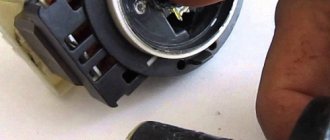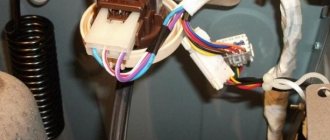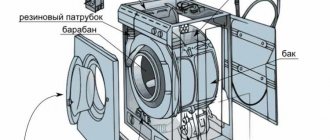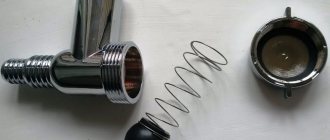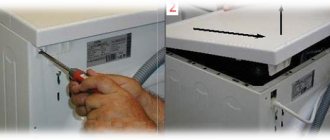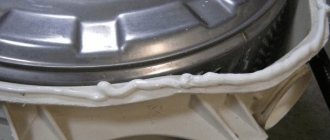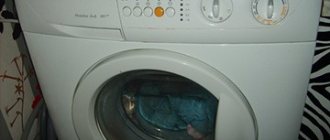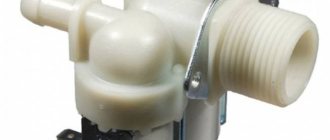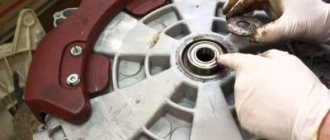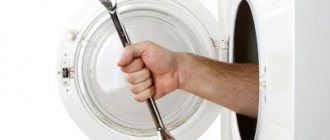Signs of a broken washing machine pump
If problems arise with the pump, the machine may :
- do not respond to the installed program;
- make humming sounds when filling or draining water;
- pour water into the drum in less than the required quantity;
- During the process of collecting water, a complete shutdown of the equipment is possible.
The operation of an automatic washing machine requires the user to remain inactive during the washing process. However, when you have to intervene, problems have arisen.
To diagnose and, if necessary, repair or replace the machine pump, you need to:
in order to detect extraneous sounds. If the machine makes a lot of noise when draining, it means there is water in the pump or some of its parts are deformed;
listen to how the machine works- open the socket to remove the blockage in the drain filter . All small and foreign objects are located here - hair, threads, buttons, seeds, etc.;
- clean the drain hose . Even if it doesn’t look damaged, you still need to remove it and wash it under hot water;
, perhaps it is jammed. It is located behind the drain filter, which needs to be unscrewed and pulled out. The impeller blades will be visible and need to be rotated. The rotation should not be too easy. If there is any debris - bra knuckles, coins, threads and hair, it must be removed;
check the operation of the impeller- check the integrity of the contacts and the functionality of the sensors going to the pump.
If during the diagnostic process the pump is identified as the cause of the problems in the washing machine, then you will have to inspect it. To get to it you will need standard tools.
If the washing machine drain pump is not repaired in time, the contacts and even the machine motor may burn out.
What is a seal in a washing machine?
An oil seal is a rubber sealing ring that is necessary to seal the gaps between static and moving parts. In our case, the oil seal is a rubber ring that prevents water from flowing out from the washing machine tank through the gaps between the tank and the shaft.
As you can see from the photo above, the oil seal is inserted onto the bearings, and inside has a hole for the shaft. As you already understood, when rotating, the shaft constantly rubs against the walls of the oil seal, thereby wearing it out. Therefore, the seal must be well lubricated to last longer.
Causes of pump failure
The pump broke down due to a malfunction of the engine, as a result of which there is no voltage to the pump.- The seal (rubber or plastic) is damaged by scale and dirt that settles on the impeller.
- Incorrect connection of the pump or failure of the water level sensor causes the pump to constantly operate.
- The pump will not be able to drain water due to a clogged filter.
- Small foreign objects destroy the impeller. It's easy to diagnose. When the pump starts, the machine makes a hooting sound.
Foreign objects
You shouldn’t be surprised, but various objects get inside the “snail” and they block the impeller of the drain pump. As a result, it does not work and the water does not drain. These foreign objects are drawn into the gap between the cuff and the drum.
This happens due to improper operation of the washing machine:
- foreign objects remain in pockets;
- small items are placed without bags.
Do you wash your shoes in the machine?
Oh yes! No
Most often, the pump's operation is blocked by the following things:
- socks;
- descendants;
- toothpicks;
- teaspoons;
- metal paper clips and pins;
- bra underwire.
You need to unscrew the cap and then pull out the concentrator. After this, remove foreign objects.
Where is the pump located
Models of washing machines Candy, LG, Whirpool, Ariston, Beko, Samsung are equipped with a pump located at the bottom. To get to it, the washing machine is laid on its side and the bottom panel is removed. The snail with the filter is attached with screws that can be unscrewed and the required part is in your hands.
If we talk about Zanussi and Electrolux models, their pump is located behind the back cover, which will need to be removed.
The most difficult models to disassemble are Bosch, AEG, Siemens. They will have to dismantle the entire front panel.
How to solve two main problems
Inspect and check parts if the machine not only leaks, but also does not work or, conversely, works without interruption.
The pump is leaking, the washing machine is not working
Have you noticed that the bottom cover of your washing machine is leaking? Water may leak from below directly onto the floor. Then it is obvious that the pump is broken.
Once you reach the pump, do this:
- Check the drain pipe, it may be faulty and leaking. It could be damaged, or the clamp between the pipe and the pump could become loose.
- Unscrew the pipe bolt and loosen the clamp with pliers.
- Remove it and inspect it for blockages and damage. When the pipe becomes clogged, it causes the washing machine to not drain.
- Now disconnect the wiring from the pump.
- Unscrew the fasteners and remove it from the case.
Inspect the pump. Hair and threads often get wrapped around the impeller, causing the pump to jam and prevent it from pumping water.
The pump cover unscrews - unscrew several screws. Remove the snail. Check all gaskets for integrity.
DIY washing machine pump repair
If after checking and cleaning the impeller the problem is not resolved, then it is more serious and you will need to disassemble the pump and carry out a more detailed inspection.
Under heavy loads, the pump is protected by fuses that are located on the winding of the part and are switched off. When the temperature normalizes, the contacts are restored.
First you need to disconnect the pump from the cochlea . In general, there are two types of fastening: simply with screws and without screws (you only need to turn the pump counterclockwise). At this stage, you can find out whether the impeller rotates on the shaft. Normally, it should spin with small delays, so-called jumps. This is due to the action of a magnet rotating in a coil. If it is difficult to turn and there is no debris, then you will have to completely disassemble the part and see if it is possible to repair the washing machine pump impeller.
The motor housing has a latch on both sides that needs to be unhooked with a screwdriver. This is if your car has a collapsible motor, but there are non-separable types. At first glance it is impossible to make out, but if you know some of the nuances, you can.
A construction hair dryer will help by heating the long part of the part, the so-called shank at a low temperature. After heating the shank, the crosspiece with the magnet is removed from the housing. Usually dirt accumulates on the magnet and in the place where it was pulled out. After cleaning, the magnet itself is removed. Next you will see the bearing, which is also cleaned and lubricated. After these procedures, the part is reassembled. There is a ring under the blades that should fit tightly into place. The seal may need to be replaced.
Bearing wear
If runout appears during shaft operation, it means the bearings are faulty.
Because of this, friction appears between the volute and the impeller, which causes problems and repairs of washing equipment pumps. The problem can be solved by replacing the bearings. In an emergency, when it is not possible to buy a new part, and washing cannot wait, only shortening the blade by no more than 2 mm will save you. This is done with a sharp knife.
After repair, the housing is installed in the coil and fixed. This concludes troubleshooting the pump on your own.
How to disassemble a washing machine pump?
In new models of machines, in order to remove the volute from the pump, it is enough to turn it counterclockwise; otherwise, you will have to unscrew the bolts. Then you should disconnect the filter and check the serviceability of the impeller to see if debris is interfering with its free rotation. The impeller may break if a foreign body enters it.
If the pump is visually in order, it is necessary to disassemble the pump motor housing. To do this, you need to carefully push the plastic latches apart and remove the motor from the reel. You can also check the presence and integrity of bearings.
As a result of their loss, the impeller begins to rub against the volute, which leads to damage to both parts. All pump repairs come down to cleaning it, replacing seals and bearings. If the pump motor is damaged, then it is more advisable to replace it. Assembling and installing the pump is done in the reverse order.
This video will help you understand in detail how to repair a washing machine pump:
How to prevent pump failure
If you follow these recommendations, you can significantly extend the life of the drain pump.
Always remove foreign objects from pockets before washing.- Use bags for washing clothes.
- In case of strong, coarse dirt, clean things, and also remove animal hair by hand before entering the machine.
- Install filters at the inlet of the filler pipe.
- Carry out scale prevention.
- When washing items with buckles or rivets, turn the items inside out.
What lubricant to use for the washing machine oil seal
Nowadays there is a large selection of lubricants on the market and any table of spare parts for washing machines also includes its availability. There are specially designed options, but the point is that you won’t need a whole package to carry out the repair yourself, and it will cost a lot.
Packages usually contain 50-100 grams of material, and with lubrication you will need 1-2 grams.
Here are some of them
:
- Huskey Lube-o-Sela lubricant (100 g - packaging);
- Hydra lubricant (100 g).
If there is no original lubricant, the washing machine oil seal can be lubricated with others, the main thing is that they meet the requirements of their future operation.
At home, you can lubricate the oil seal of a washing machine with the following lubricants:
:
- Litol (or Litol-24). It has chemical and mechanical stability in the temperature range from 40 to +120 degrees Celsius.
- Cyatim 221. Performs excellently in high friction units and does not change its basic properties at temperatures up to +150 degrees.
Also many automotive and other solid lubricants, of which there are a huge number today, including silicone analogues of washing machine oil seals.
